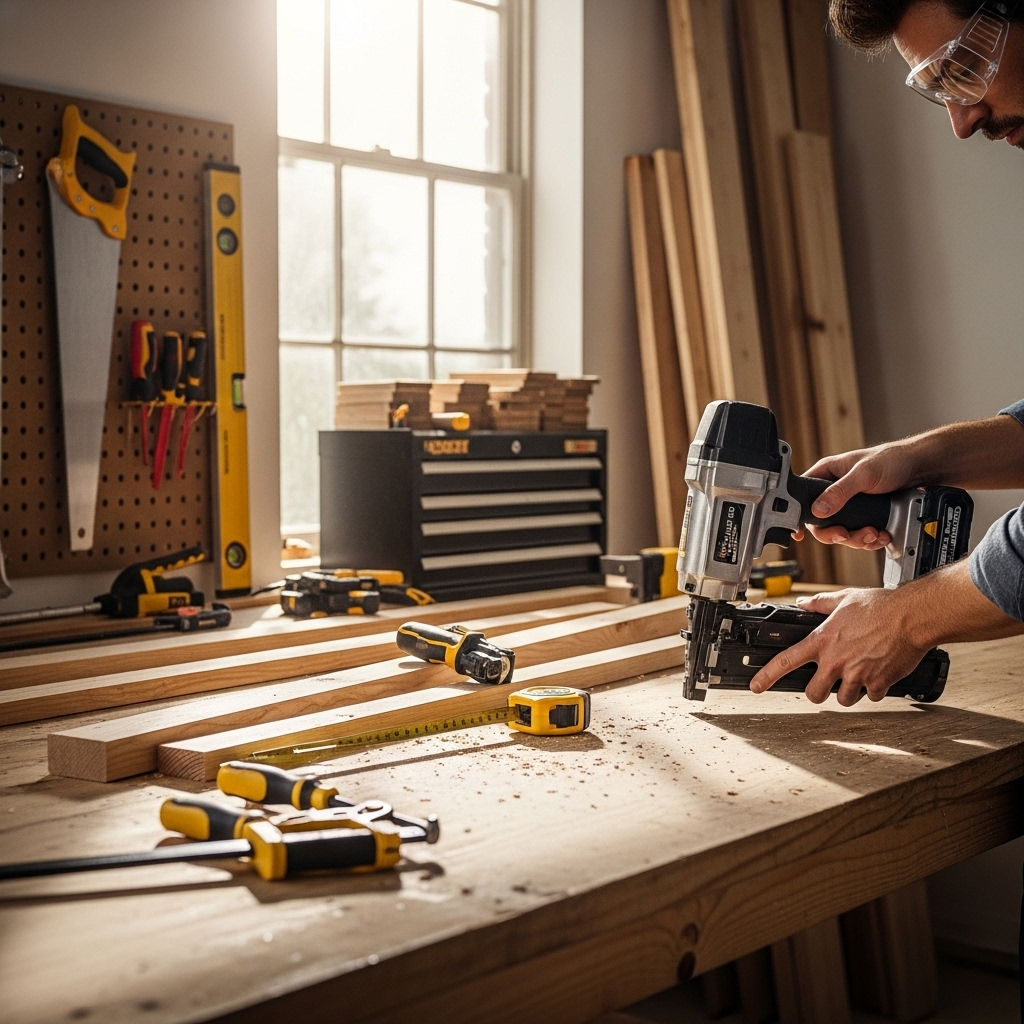Using a nail gun for door frame installation is quick, secure, and makes a professional finish achievable for DIYers. This guide shows you exactly how to use your nail gun safely and effectively to hang door frames perfectly every time. Get ready to nail your next project!
Hey there, DIY enthusiasts! Jack Shaffer, your friendly neighborhood Nailerguy, here. Ever stared at a bare doorway and thought, “This needs a door, but that frame looks like a job for a pro?” I get it. Installing a door frame can seem a bit daunting, especially if you’re not a seasoned carpenter. You might picture yourself wrestling with nails and a hammer, trying to get everything plumb and square. But what if I told you there’s a tool that can make this job not only easier but also faster and more precise? That’s right, we’re talking about the humble, yet mighty, nail gun. It’s a total game-changer for projects like door frame installation, giving you that perfect, long-lasting hold with minimal fuss. Forget the frustration; with a little know-how and the right approach, you’ll be installing door frames like a seasoned pro in no time. Let’s dive into how your nail gun can become your best friend for this task!
We’ll cover everything from choosing the right nail gun and nails to the step-by-step process of getting that frame perfectly installed. We’ll also touch on safety tips because, as always, that’s my top priority. Stick around, and you’ll see just how achievable this project is!
Table of Contents
Why Use a Nail Gun for Door Frame Installation?
Let’s be honest, a hammer and nails can get the job done, but they come with a learning curve and can be time-consuming. When it comes to door frames, you need speed, precision, and a strong hold. This is where a nail gun truly shines. It drives nails quickly and consistently, which is crucial for keeping the frame plumb and square while you work. Plus, it significantly reduces the physical effort required, making the job less tiring and more enjoyable.
Here are some of the key benefits:
- Speed and Efficiency: Nail guns drive fasteners in a fraction of a second, dramatically speeding up the installation process compared to manual nailing.
- Consistency: Each nail is driven to a consistent depth, ensuring a secure and uniform hold throughout the frame.
- Reduced Fatigue: Less hammering means less strain on your wrists and arms, especially helpful for longer projects or when working overhead.
- Professional Finish: The consistent depth and placement of nails result in a cleaner, more professional-looking finish.
- Ease of Use: Once set up, operating a nail gun is straightforward, making it accessible even for beginners.
- Versatility: Different types of nail guns can handle various materials and nail sizes, offering flexibility for different framing needs.
Choosing the Right Nail Gun and Nails

Not all nail guns are created equal, and selecting the right one for door frame installation is step one to success. For framing tasks like this, you’ll typically want a framing nailer. These are powerful tools designed to drive larger nails into dense wood. There are a few main types of framing nailers to consider:
Types of Framing Nail Guns
- Pneumatic Nailers: These are the workhorses of the framing world. They require an air compressor and air hose to operate. They are powerful, reliable, and generally the most cost-effective in the long run for frequent use. However, the compressor and hose can add bulk and limit mobility.
- Cordless (Battery-Powered) Nailers: These offer incredible convenience and portability. They run on rechargeable batteries and don’t require a compressor or cord. Modern battery technology has made them powerful enough for most framing tasks. They are often a bit heavier and more expensive upfront than pneumatic models.
- Cordless (Gas/Propane Cartridge) Nailers: These use a combination of a battery and a disposable fuel cartridge to power the nailer. They offer good power and portability but require you to purchase fuel cells, adding an ongoing cost, and can sometimes have a distinct smell.
For door frame installation, a cordless framing nailer is often the sweet spot for DIYers due to its portability and ease of use, especially if you don’t already own an air compressor. If you plan on doing a lot of framing or construction, owning a good quality air compressor and a pneumatic framing nailer is a solid investment.
Choosing the Right Nails
The type of nails you use is just as important as the nail gun itself. For door frames, you’ll want nails that are strong enough to hold the frame securely to the wall studs. Common choices include:
- Framing Nails: These are typically 2-inch to 3-1/2-inch long and come in various gauges (thickness) and head styles.
- Ring Shank Nails: These have grooves on the shank that grip the wood fibers, providing extra holding power. They are excellent for framing applications where pull-out resistance is important.
- Smooth Shank Nails: These are standard framing nails. They are easier to drive but offer less holding power than ring shank nails.
- Angled vs. Straight Nails: Framing nailers and nails often come in specific angles (like 21° or 30°). Make sure the nails you buy match the angle capacity of your nail gun. Angled nails are essential for reaching studs at tricky angles, which is common in door frame installation.
Pro Tip: Always check your nail gun’s manual for the recommended nail size, length, and type. Using the wrong nails can damage the tool or lead to weak joints.
Essential Tools and Materials for Door Frame Installation
Before you power up your nail gun, gather everything you’ll need. Having all your tools and materials ready will make the process smooth sailing and prevent unnecessary trips to the hardware store. Essential items include:
| Tool/Material | Description |
|---|---|
| Framing Nail Gun | (Pneumatic, Cordless Battery, or Cordless Gas) Choose one appropriate for framing. |
| Compatible Nails | Framing nails, typically 2-3.5 inches, in the correct angle and gauge for your nailer. |
| Air Compressor & Hose (If using a pneumatic nailer) |
Ensure compressor has adequate PSI and CFM for your nail gun. |
| Level | A 6-foot level is ideal for checking plumb and level of the frame. |
| Measuring Tape | For accurate measurements of the opening and door. |
| Pencil | For marking measurements and adjustments. |
| Safety Glasses | Absolutely essential to protect your eyes from flying debris or nails. |
| Hearing Protection | Nail guns can be loud, especially pneumatic ones. |
| Work Gloves | To protect your hands and improve grip. |
| Door Frame Kit (Pre-hung or Slab) | This includes the door itself and the jamb (frame pieces). Pre-hung doors come with the door already attached to the frame for easier installation. |
| Shims | Wooden or plastic wedges used to level and plumb the frame within the rough opening. |
| Drill/Driver | For pre-drilling pilot holes if needed, or for attaching hinges if installing a slab door. |
| Caulk Gun & Exterior Caulk | For sealing gaps around the exterior of the frame against the wall sheathing (if applicable). |
| Stapler (Optional) | For securing the trim or casing later. |
Safety First! Using Your Nail Gun Responsibly

Nail guns are powerful tools, and safety should always be your number one priority. A moment of carelessness can lead to serious injury. Here’s how to stay safe:
- Read the Manual: Every nail gun is slightly different. Familiarize yourself with your specific model’s features, operation, and safety guidelines.
- Wear Personal Protective Equipment (PPE): Always wear safety glasses. Hearing protection is also highly recommended. Work gloves can provide a better grip and protect your hands.
- Never Point the Nail Gun at Anyone: Treat it like a firearm. Never point it at yourself or others, even if it’s not armed.
- Keep Fingers Off the Trigger When Not Firing: Only engage the trigger when you intend to drive a nail.
- Engage the Safety Contact Tip: Most nail guns have a safety mechanism on the nose that must be pressed against the wood for the gun to fire. Ensure this contact tip is properly engaged.
- Disable When Not in Use: Disconnect from the air hose (pneumatic), remove the battery (cordless battery), or disable the firing mechanism when moving the tool, clearing jams, or leaving it unattended.
- Clear Jams Safely: If a nail jams, disconnect the power source (air, battery, or gas cartridge) before attempting to clear it.
- Use in a Well-Ventilated Area: Especially important for gas-powered nailers due to exhaust fumes.
- Be Aware of Your Surroundings: Ensure no one is behind the material you are nailing into, as nails can sometimes pass through thin wood.
A great resource for tool safety is the Occupational Safety and Health Administration (OSHA). They offer detailed guidelines on power tool safety, including nail guns. You can find helpful information on their Power Tools page.
Step-by-Step: How to Use a Nail Gun for Door Frame Installation
Alright, you’ve got your tools, your nail gun is prepped, and you’re ready to go. Let’s break down the process of installing a door frame using your nail gun. We’ll assume you’re installing a pre-hung door, as this is the most common approach for DIYers and where nail guns are incredibly useful for securing the jamb to the wall studs.
Step 1: Prepare the Rough Opening
The rough opening is the framed space in the wall where the door will go. It needs to be slightly larger than the door frame itself to allow for adjustments. Inspect the opening to ensure it’s relatively plumb and square. If it’s significantly out of square, you might need to adjust the framing before proceeding, but minor adjustments can be made with shims.
Clean Out Debris: Remove any loose insulation, drywall scraps, or debris from the opening. This ensures the door frame can sit flush against the studs.
Step 2: Position the Door Frame
Carefully place the pre-hung door unit into the rough opening. Start with the hinges side (the “hinge jamb”) and work your way around. The goal is to get the frame centered and as plumb, level, and square as possible before you start securing it.
Tip: It’s often easier to do this step with a helper. One person can hold the frame while the other checks for plumb and level.
Step 3: Shim the Frame
This is a crucial step for a correctly functioning door. Shims are thin pieces of wood or plastic used to fill any gaps between the door frame and the rough opening studs. They ensure the frame is perfectly plumb (vertically straight) and level (horizontally straight), and that the door swings freely without binding.
Hinge Jamb: Start with the hinge jamb. Place shims at the top, middle, and bottom of these studs, behind where the hinges will be. Drive a nail through the frame, the shims, and into the wall stud to hold them in place temporarily. Use your level constantly. You want the hinge jamb to be perfectly plumb.
Strike Jamb (Latch Side): Once the hinge jamb is plumb and secure, position the strike jamb. Place shims at the top, middle, and bottom of the studs along this side as well. Ensure the frame is plumb and that there’s an even, small gap all around the door slab itself when it’s closed and latched in the center. The gap should be consistent, usually around 1/16th to 1/8th of an inch. Use your level to ensure this side is also plumb.
Head Jamb (Top): Check that the head jamb (the top piece of the frame) is level. Sometimes, you might need to shim here too, especially if the rough opening’s top plate isn’t perfectly flat. Ensure the gap between the door slab and the head jamb is also consistent.
Step 4: Secure the Frame with Your Nail Gun
Now it’s time for the nail gun to do its magic! You’ll be driving nails through the door jamb, shims, and into the wall studs. This provides a strong, stable hold.
Nailing the Hinge Jamb:
- Load your nail gun with the appropriate framing nails.
- Position the nail gun against the hinge jamb, ensuring the contact tip is flush against the wood.
- Aim the nose of the nailer at the stud behind the jamb.
- Drive nails through the jamb, through the shims, and into the stud. Use your level to confirm plumbness as you go. Drive nails at the top and bottom of the jamb, and at least one near the middle where the hinge is located. You can also add more nails for extra security.
- Important Safety Note: Make sure you are nailing into solid wood studs and not just drywall. Your nail gun’s depth adjustment might need to be set to drive the nail just flush or slightly below the surface of the jamb.
Nailing the Strike Jamb:
- With the hinge jamb secured, focus on the strike jamb.
- Ensure the door still swings freely and closes properly. Make fine adjustments with shims if needed.
- Once satisfied with the alignment, drive nails through the strike jamb, through the shims, and into the studs. Place nails near the top and bottom, and also around the area where the door latch will engage (the “strike plate” area) for solid support.
- Setting the Depth: You want the nails to be driven just flush with or slightly below the surface of the jamb. Too deep, and you’ll damage the wood fibers. Too shallow, and the nail head will be visible and could snag. Most nail guns have an adjustable depth setting.
Nailing the Head Jamb:
- Finally, secure the head jamb.
- Drive nails through the head jamb into the top plate or header of the rough opening, and also into the side jambs for added rigidity.
Table of Nail Placement (General Guideline for a Pre-Hung Door):
| Frame Section | Nail Location | Number of Nails (approx.) | Purpose |
|---|---|---|---|
| Hinge Jamb | Top, Middle (near hinge), Bottom studs | 3-5 per stud | Secures jamb, maintains plumbness. |
| Strike Jamb | Top, Middle, Bottom studs; around strike plate area | 3-5 per stud | Secures jamb, maintains plumbness, supports latch. |
| Head Jamb | Into top plate/header; into side jambs | 3-5 nails | Secures top of frame, adds rigidity. |
Step 5: Test the Door
Once all the framing nails are in, gently close and open the door several times. Does it swing smoothly? Does it latch securely? Are there any gaps that are too wide or too tight?
If the door binds or doesn’t operate correctly, you may need to remove a few nails, reposition the shims, and re-nail. This is where the speed of the nail gun is a blessing – it makes these minor adjustments much easier.
Step 6: Trim and Finish
After you’re satisfied with the fit and operation of the door, you can trim the protruding shims flush with the door jamb using a flush-cut saw or a utility knife. You can then install your interior trim (casing) around the door frame. A smaller finish nailer is perfect for this job, providing a clean and unobtrusive finish.
If this is an exterior door, ensure you seal any


